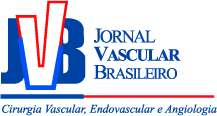Experimental model for the study of retrograde flow
Modelo experimental para estudo da circulação retrógrada
Cesar Roberto Busato; Carlos Alberto Lima Utrabo; Leandro Cavalcante Lipinski; Mario Rodrigues Montemór Netto; Eduardo de Souza Tolentino; Fernanda Aparecida de Oliveira Busato Nascimento; Marcio Dias Guilherme Filho
Abstract
Keywords
Resumo
Palavras-chave
References
Norgren L, Hiatt WR, Dormandy JA, Nehler MR, Harris KA, Fowkes FGR. Inter-society consensus for the Management of Peripheral Arterial Disease (TASC II). Eur J Vasc Endovasc Surg. 2007;33(^sSuppl 1):S1-75.
Bae JI, Won JH, Han SH. Endovascular revascularization for pacients with critical limb Ischemia: Impact on wound healing and long term clinical results in 189 limbs. Korean J Radiol. 2013;14(3):430-8.
Busato CR, Utrabo CA, Gomes RZ. Utilização da safena magna in situ para arterialização do arco venoso do pé. J Vasc Bras. 2010;9(3):119-23.
Taylor RS, Belli AM, Jacob S. Distal venous arterialisation for salvage of critically ischaemic inoperaable limbs. Lancet. 1999;354(9194):1962-5.
Alexandrescu V, Ngongang C, Vincent G, Ledent G, Hubermont G. Deep calf veins arterialization for inferior limb preservation in diabetic patients with extended ischaemic wounds, unfit for direct arterial reconstruction: preliminary results according to an angiosome model of perfusion. Cardiovasc Revasc Med. 2011;12(1):10-9.
Busato CR, Utrabo CAL, Gomes RZ, Housome JK, Hoeldtke E, Busato CD. Arterialização do arco venoso do pé para tratamento da tromboangeíte obliterante. J Vasc Bras. 2008;7(3):267-71.
Djoric P. Early individual experience with distal venous arterialization as a lower limb salvage procedure. Am Surg. 2011;77(6):726-30.
Gavrilenko AV, Skrylev SI. Long-term results of venous blood flow arterialization of the leg and foot in patients with critical lower limb ischemia. Angiol Sosud Khir. 2007;13(2):95-103.
Lengua AF, Madrid A, Acosta C, Vargas J. Arterializacion venosa temporal del pie diabético. J Vasc Bras. 2010;9(1):14-20.
Lu XW, Idu MM, Ubbink DT, Legemate DA. Meta-analysis of the clinical effectiveness of venous arterialization for salvage of critically ischaemic limbs. Eur J Vasc Endovasc Surg. 2006;31(5):493-9.
Mutirangura P, Ruangsetakit C, Wongwanit C, Sermsathanasawadi N, Chinsakchai K. Pedal bypass with deep venous arterialization: the therapeutic option in critical limb ischemia and unreconstructable distal arteries. Vascular. 2011;19(6):313-9.
Özbek C, Kestelli M, Emrecan B. A novel approach: ascending venous arterialization for atherosclerosis obliterans. Eur J Vasc Endovasc Surg. 2005;29(1):47-51.
Houlind K, Christensen J, Hallenberg C, Jepsen JM. Early results from an angiosome-directed open surgical technique for venous arterialization in patients with critical lower limb ischemia. Diabet Foot Ankle. 2013;4:1-6.
Schreve MA, Minnee RC, Bosma J, Leijdekkers VJ, Idu MM, Vahl AC. Comparative study of venous arterialization and pedal bypass in a patient cohort with critical limb ischemia. Ann Vasc Surg. 2014;28(5):1123-7.
Sasajima T, Kikuchi S, Ishikawa N, Koyama T. Skin temperature in lower hind limb subjected to distal vein arterialization in rats. Adv Exp Med Biol. 2014;812:361-8.
Sasajima T, Koyama T. Biological maintenance of distal vein arterialization. Adv Exp Med Biol. 2013;765:245-50.
Ozbek C, Kestelli M, Bozok S. Surgical stimulation of angiogenesis. Asian Cardiovasc Thorac Ann. 2014;22(1):36-9.
Koyama T, Sugihara-Seki M, Sasajima T, Kikuchi S. Venular valves and retrograde perfusion. Adv Exp Med Biol. 2014;812:317-23.
Lengua AF, Nuss JM, Lechner R, Kunlin J. Arterialization of the venous network of the foot through a bypass in severe arteriophatic ischemia. J Cardiovasc Surg (Torino). 1984;25(4):357-60.
Lengua AF. Le pontage d’artérialisation veineuse distale peut-il être bénéfique au pied diabétique avec nécrose?. Chirurgie. 1994;120(13):143-52.

